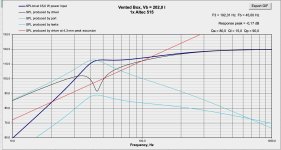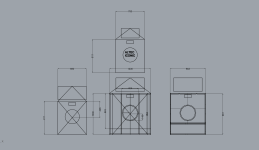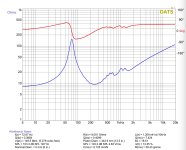nail and glue it together
Glue and clamps, nails will weaken things.
Is the box well-tuned, or is the vent guessed?
dave
Early 1937 812 Iconic shows 29.5" high 25.5 wide 17.5 deep
I would just capture the look, and use 18mm plywood with much more modern bracing.
Rather large panels, need good bracing. Nothing too magical about resonating, ringing cabinets.
Seems like they have the plywood edges showing on the front, which was also done 1942/43
With the more common Iconic style cabinet. Which I like the raw simplicity for some reason.
far as I can tell around 45 with the Hammer Tone silver paint jobs is when they made the front baffle
larger and hide the plywood edges.
Always fun to stumble though the Altec Catalogs at the Heritage Site
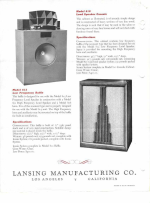

As noted, plywood edges show on early cabinets.
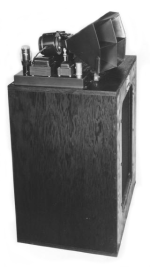
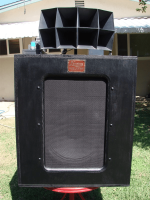
Later on the silver hammer tone cabinets hide the edges
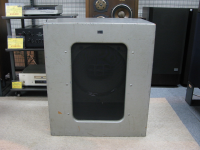
I would just capture the look, and use 18mm plywood with much more modern bracing.
Rather large panels, need good bracing. Nothing too magical about resonating, ringing cabinets.
Seems like they have the plywood edges showing on the front, which was also done 1942/43
With the more common Iconic style cabinet. Which I like the raw simplicity for some reason.
far as I can tell around 45 with the Hammer Tone silver paint jobs is when they made the front baffle
larger and hide the plywood edges.
Always fun to stumble though the Altec Catalogs at the Heritage Site


As noted, plywood edges show on early cabinets.


Later on the silver hammer tone cabinets hide the edges

Last edited:
Oh.. Eeven with a nailer? sure, I could also clamp it together. I've gotten help to calculate the volume of the bass reflex box, these things are a bit over my head.., but 202L should be a suitable volume, will also get help to figure out the correct vent dimensions, but will definitely make the vent rectangular; will first get a rough estimate on the vent dimensions through calculation; then make some sort of adjustable vent to see what works out the best.Glue and clamps, nails will weaken things.
Is the box well-tuned, or is the vent guessed?
dave
Yesterday I figured out that the original dimensions of the Iconic cabinet will look very small beneath the 1005 multicell horn; it must be much larger than the horn used with the early Iconic cabinets? Will try to rearrange the drawings to figure out how to keep the correct proportions on the box, it will become a bigger box, trying to figure out a way of keeping the proportions and still keep the 202L cabinet.
1. first I was thinking making open chambers to fill out the dimensions of the box, but this would probably make the box to resonate badly?
2. second thought is to rearrange the drawing, see second attachment, last sketch on the lower right hand, and make a sand (dry ) filled plywood box, beneath the correct ( 202L ) cabinet... ?
This is definitely a project for the long run...
Attachments
That alignment is not great. You need to lose the dip just before it ro;;s off. As is may give you more theoretical LF extention, but you uually pay in other ways.
Bracing. As an example this is a 135 litre monster miniOnken for 16” TAD.
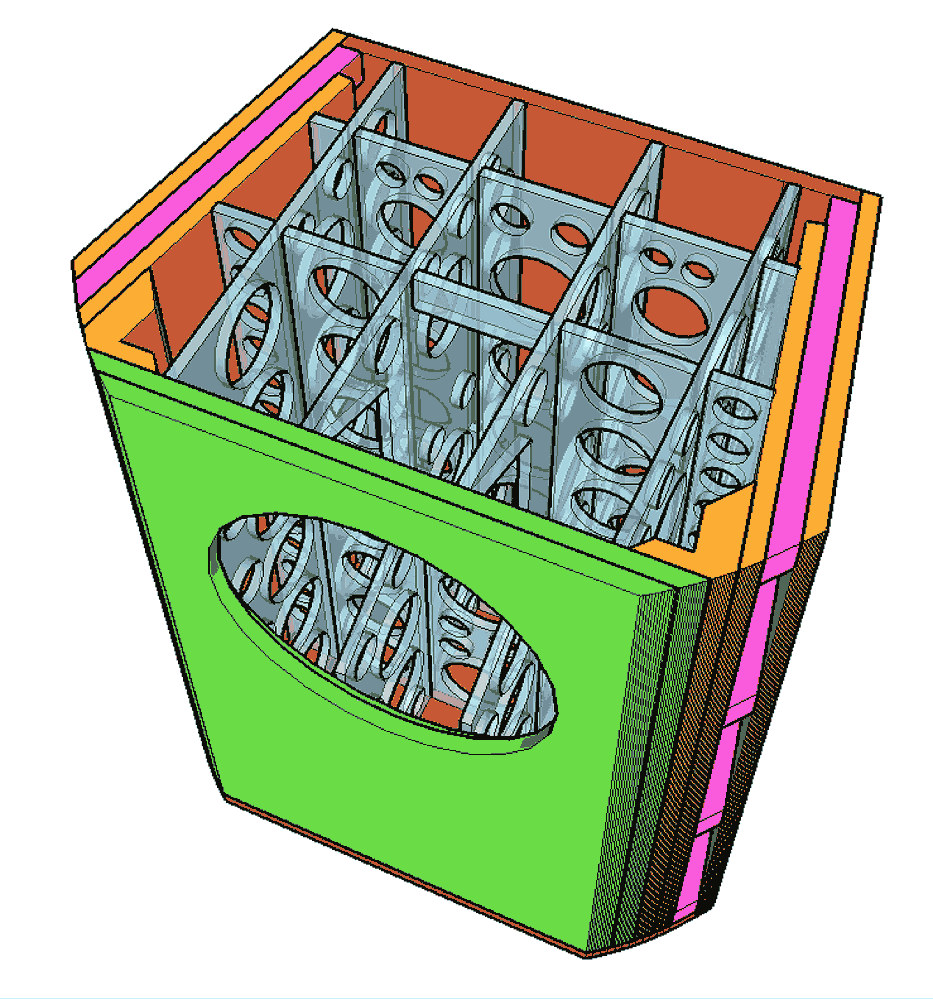
dave
dave
Bracing. As an example this is a 135 litre monster miniOnken for 16” TAD.

dave
dave
Is there a suitable crossover for hifi if you use one with parallel walls? I’m looking at the 817Yeah, one of the original Lansing prosound cabs relegated to JBL and definitely not suitable for any typical HIFI/HT app, ditto the H110 or any horn with parallel walls as I learned the hard way with 210 cabs.
Re minimum distance, it's more about polar response at 'x' distance before the 1st room reflections. If going by WLs, then at least 1 WL (full length horn) of lowest desired speaker loading, so if 5 m away, then lowest wide BW summation is ~344/5 = 68.8 Hz, so falls right in line with your ~70 Hz usable response. 😉
Hi! I’m just scratching the surface here, but I think the easiest way is to this is to use a digital crossover + doing measurements on the driver when installed in the cabinet, and go from there?
I have a miniDPS 2x4HD and a Umik1.
I recently got help to adjust a pair of full range drivers. A pair of 755Es, installed in a pair of diy Altec 618s, sealed cabs, made of 15mm pine ply, the result was way beyond all expectations; especially fun! —since I’ve never gotten these E’s to sing properly.. we managed to integrate a VLD12 ribbon tweeter too… driven by a separate power amp.
I recommend leaning on someone that know, at least basics, on doing this … or doing more research net on actual product.
BTW… I think GM is pointing out that parallel walls is not the way to go…? I have landed to use a vented box, not a combination of a horn and bass reflex…
I have a miniDPS 2x4HD and a Umik1.
I recently got help to adjust a pair of full range drivers. A pair of 755Es, installed in a pair of diy Altec 618s, sealed cabs, made of 15mm pine ply, the result was way beyond all expectations; especially fun! —since I’ve never gotten these E’s to sing properly.. we managed to integrate a VLD12 ribbon tweeter too… driven by a separate power amp.
I recommend leaning on someone that know, at least basics, on doing this … or doing more research net on actual product.
BTW… I think GM is pointing out that parallel walls is not the way to go…? I have landed to use a vented box, not a combination of a horn and bass reflex…
Btw… —any interest in figuring a better alignment if I source the TS measurements we did on the reconed 515?That alignment is not great. You need to lose the dip just before it ro;;s off. As is may give you more theoretical LF extention, but you uually pay in other ways.
Bracing. As an example this is a 135 litre monster miniOnken for 16” TAD.

dave
dave
Correct, the eigenmodes comb filter with the horn's output, so make one slanted ala the 825 cab.BTW… I think GM is pointing out that parallel walls is not the way to go…? I have landed to use a vented box, not a combination of a horn and bass reflex…
Anyone willing to give it a go?
Referring to my last reply here, with measured TS parameters of 5151RWB.
This is above my own knowledge; calculating / running simulations an ideally volume of a ventet box for any driver….
Volumes in size above first proposal (~200L ) is not a problem.
Referring to my last reply here, with measured TS parameters of 5151RWB.
This is above my own knowledge; calculating / running simulations an ideally volume of a ventet box for any driver….
Volumes in size above first proposal (~200L ) is not a problem.
Thanks! If I understand you correctly:
MAIN QUESTION:
1. Do I got a damaged 515RWB, or was this driver ONLY made for horn applications?
--It was taken out from a 1940s H110 cabinet; that's combination of a horn and bass reflex cabinet, right?
The driver did have low measurements with a multimeter before the re-cone : 8.2 ohms, according to others it should have been above that measurement, but still within usable range.
Fs/ Qts RATIO COMPARISON:
The "standard" Fs/Qts ratio of a 515B = 24.7/0.17 = 145.3
My 515RWB gets 187, is that a too high ratio?
I have also on hand, NOT INSTALLED, a complete second paper cone with a newly produced coil with 20ohms windings inkl. new phenolic spyder.
I do not find standard TS parameters of the 515RWB ( produced from 1945-1955 )
I've been told that the 515B ( produced from 1955-1978 )had better capabilities handling low frequencies, the 515B was also more versatile when it came to use different enclosures?
REF, understanding Fs / Qts : https://www.diyaudio.com/community/threads/a-curiosity-ratio-fs-qts.251388/
REF, TS parameters of the 515B : http://alteclansingunofficial.nlenet.net/Thiele-Small.html
MAIN QUESTION:
1. Do I got a damaged 515RWB, or was this driver ONLY made for horn applications?
--It was taken out from a 1940s H110 cabinet; that's combination of a horn and bass reflex cabinet, right?
The driver did have low measurements with a multimeter before the re-cone : 8.2 ohms, according to others it should have been above that measurement, but still within usable range.
Fs/ Qts RATIO COMPARISON:
The "standard" Fs/Qts ratio of a 515B = 24.7/0.17 = 145.3
My 515RWB gets 187, is that a too high ratio?
I have also on hand, NOT INSTALLED, a complete second paper cone with a newly produced coil with 20ohms windings inkl. new phenolic spyder.
I do not find standard TS parameters of the 515RWB ( produced from 1945-1955 )
I've been told that the 515B ( produced from 1955-1978 )had better capabilities handling low frequencies, the 515B was also more versatile when it came to use different enclosures?
REF, understanding Fs / Qts : https://www.diyaudio.com/community/threads/a-curiosity-ratio-fs-qts.251388/
REF, TS parameters of the 515B : http://alteclansingunofficial.nlenet.net/Thiele-Small.html
Below its 1st eigenmode, so if 24" high, then 13543.3/2/24 = ~282 Hz.Is there a suitable crossover for hifi if you use one with parallel walls? I’m looking at the 817
Firstly, IIRC the RWB originally meant it used the original Lansing 15x cones in Altec's new 15" frame for cinema/etc., replacements, so designed for high output impedance amps with either fixed or variable impedance tone controls to get the desired frequency response.1. Do I got a damaged 515RWB, or was this driver ONLY made for horn applications?
My 515RWB gets 187, is that a too high ratio?
I do not find standard TS parameters of the 515RWB ( produced from 1945-1955 )
I've been told that the 515B ( produced from 1955-1978 )had better capabilities handling low frequencies, the 515B was also more versatile when it came to use different enclosures?
As such then, there's nothing wrong with yours, just has an incredibly powerful magnet, so for horns or (relatively) small sealed, reflex speakers.
T/S per se didn't exist, just the underlying specs, Fs, Mms, Mmd, n0, etc.. FWIW, when I visited the plant in '68, quality assurance (QA) just measured n0 (scroll down to bottom).
Correct, changing over time as the electronics changed from tube to SS and all that implied to the point where many had relatively weak motors due to increasingly prohibitive AlNiCo cost.
Regardless, the 'name of the game' if I was still active is I'd use Samarium cobalt (SmCo), which can achieve the original WE/Lansings's field coil strengths required for the 'heart attack' fast transients live music achieves.
Interesting so you could actually cross a 16” 816 (423Hz) higher then a 32.25” 817 or 210 (210 hz) without issue?Below its 1st eigenmode, so if 24" high, then 13543.3/2/24 = ~282 Hz.
Hi,Firstly, IIRC the RWB originally meant it used the original Lansing 15x cones in Altec's new 15" frame for cinema/etc., replacements, so designed for high output impedance amps with either fixed or variable impedance tone controls to get the desired frequency response.
As such then, there's nothing wrong with yours, just has an incredibly powerful magnet, so for horns or (relatively) small sealed, reflex speakers.
T/S per se didn't exist, just the underlying specs, Fs, Mms, Mmd, n0, etc.. FWIW, when I visited the plant in '68, quality assurance (QA) just measured n0 (scroll down to bottom).
Correct, changing over time as the electronics changed from tube to SS and all that implied to the point where many had relatively weak motors due to increasingly prohibitive AlNiCo cost.
Regardless, the 'name of the game' if I was still active is I'd use Samarium cobalt (SmCo), which can achieve the original WE/Lansings's field coil strengths required for the 'heart attack' fast transients live music achieves.
I'm trying to warp my heard around the information you're sharing:
If I'm understanding you correctly; the alnico magnet of the 515 has a almost 10 times more impact on the n0 measurement than a random modern, very well, produced woofer / midrange drivers?
515 RWB n0=13.35%
Random modern woofer / midrange with alnico magnet : n0=1.42%
Q1. You're mentioning variable impedance tone controls; can this be a passive adjustment done after my Quad II´power amps ( set to 16 ohms output taps ) ? if so, any good alternatives on where to look for more information on this?
Q2. how does a variable impedance tone controller impact, an already defined set of parameters; set by the crossover/dividing network between the 515 / 288 + 1005 / and the bass reflex cabinet; I'm guessing the variable impedance controller is an addition to everything else? --put into the signal chain, after everything else is figured out?
Not per se; it has less moving mass + a sufficiently powerful motor to get the desired gain BW @ 'x' eff., but a driver can have a very heavy moving mass if it has a much more powerful motor to compensate to get the desired BW, but with less eff. as the trade-off.
Tube variable tone controls, so built into a pre-amp or receiver or just an inline pot or rheostat + autoformer or a simple power resistor.
Tube variable tone controls, so built into a pre-amp or receiver or just an inline pot or rheostat + autoformer or a simple power resistor.
Aha… I understand. Thanks —Those are WAY beyond ..! I do got a Quad 44, pre with following capabilities:
«The 44 has tone controls, consisting of Filter, Bass and Tilt which enable the listener to correct for those acoustic problems which are amenable to frequency response shaping»—hifiengine
How’s the impedance curve on the 515RWB and the 288 Hollywood in general?—is it like a jigsaw? ( one of the most notorious, the Quad ESL57 )
If not, I’m considering a Gainclone; To my knowledge: that’s the closest way into a sound; something that could at least adapt to a 2a3 / 300B SET, but if I remember correctly ; the Gainclone does not handle low impedances very well…
If anyone interested in helping out with a better box alignment, it would be greatly appreciated.
«The 44 has tone controls, consisting of Filter, Bass and Tilt which enable the listener to correct for those acoustic problems which are amenable to frequency response shaping»—hifiengine
How’s the impedance curve on the 515RWB and the 288 Hollywood in general?—is it like a jigsaw? ( one of the most notorious, the Quad ESL57 )
If not, I’m considering a Gainclone; To my knowledge: that’s the closest way into a sound; something that could at least adapt to a 2a3 / 300B SET, but if I remember correctly ; the Gainclone does not handle low impedances very well…
If anyone interested in helping out with a better box alignment, it would be greatly appreciated.
Last edited:
- Home
- Loudspeakers
- Multi-Way
- Altec Lansing H110 (1940s A5) cabinet plans
